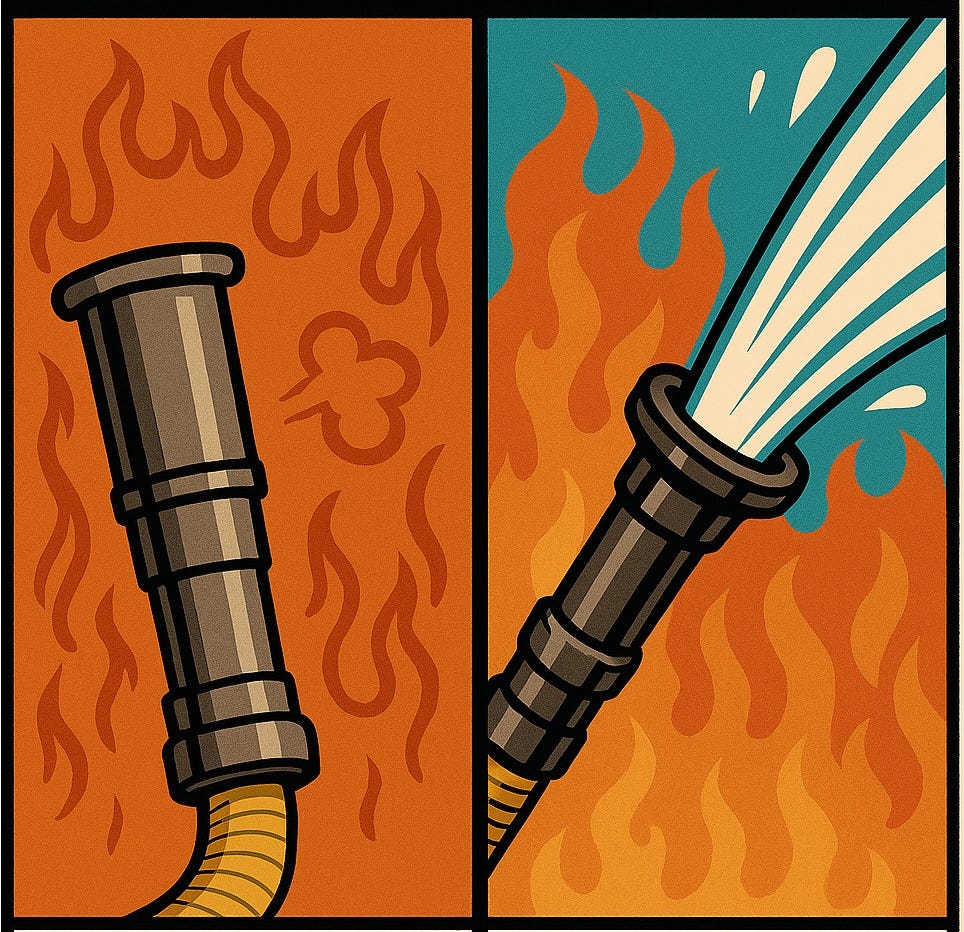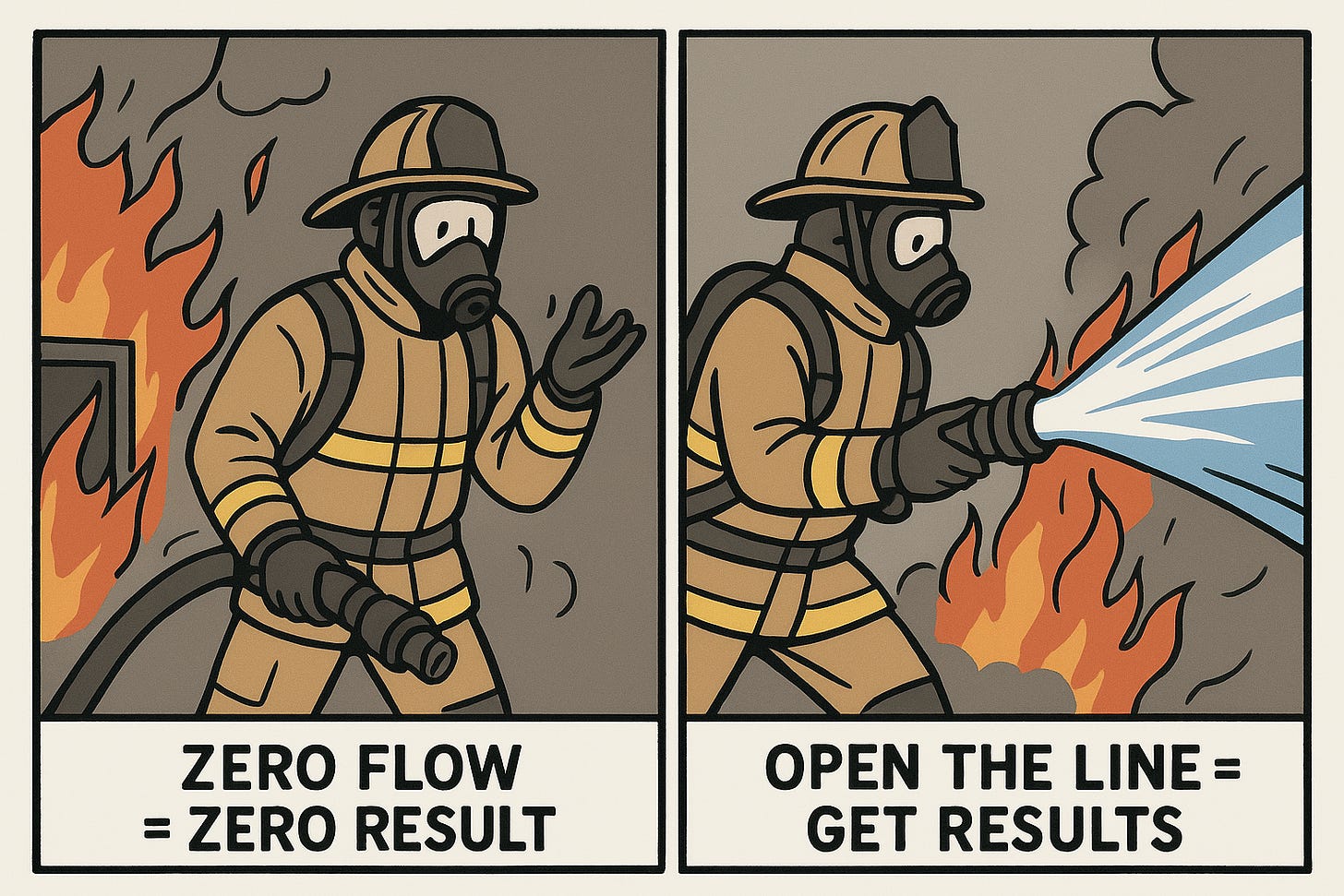At a firefighting class I took a while back, the instructor reminded us of something so simple it’s easy to overlook: a closed hose line has a flow rate of zero. If you want results — no more fire — you have to open that line and get water moving. You can complicate things all day long with tactics and techniques, but it really comes down to the basics: “get the wet stuff on the red stuff.”
Zero flow equals zero result.
That principle doesn’t just apply on the fireground. It applies to life, and especially to fitness. Nothing gets you nothing.
The problem is, in today’s world of information overload, we’re drowning in “tactics and techniques.” Keto or intermittent fasting? CrossFit or yoga? HIIT or Zone 2 cardio? It’s easy to get so overwhelmed that we don’t even start. But just like in firefighting, the basics are what make the difference.
So let’s get back to four fundamentals of fitness that have nothing to do with your weight: balance, flexibility, muscular strength, and cardiovascular endurance. These are the building blocks that keep you moving, working, and living well — whether you’re pulling hose, carrying groceries, or chasing grandkids.
Balance: Your First Line of Defense
On the fireground, balance is everything. You’re climbing ladders, working on uneven ground, or moving in zero visibility with 50 pounds of gear strapped on. Lose your balance, and you’re not just slowing down the job — you’re putting yourself and your crew at risk.
But balance isn’t just a firefighter thing. According to the CDC, one in four adults over 65 falls each year, and falls are the leading cause of injury-related deaths in older adults. For responders, that means two things: first, we need balance to do our jobs safely. Second, we need to train it now so we’re not sidelined later in life.
Think of balance training as your personal RIT team — it’s there to catch you before things go bad. Here are three simple drills you can use to start training it today:
Basic: Single-Leg Stand
Stand on one foot for 10–20 seconds. Keep a hand near a wall, counter, or rig for support if needed. Switch sides.
Why it matters: Builds foundational stability for everything from climbing ladders to roof ops to stepping down off the rig.Intermediate: Step-Overs (Forward and Lateral)
Set a rolled towel, broomstick, or foam roller on the floor. Step over it slowly, forward and back, then sideways.
Why it matters: Mimics stepping over hose lines, debris, or curbs — real world movement training.Advanced: Single-Leg Deadlift
Stand on one leg, hinge at the hips, and reach your opposite hand toward the floor while extending your free leg behind you. Return to standing.
Why it matters: Trains balance, coordination, and posterior chain strength — critical for lifting and moving under load.
👉 Want to see these in action? I’ve recorded short demo videos of each for my YouTube channel.
Flexibility: The Range to Respond
Strength without flexibility is like having a charged line but no room to maneuver it. You might have the power, but you can’t get it where it needs to go. Tight shoulders, hips, or hamstrings don’t just limit performance — they set you up for chronic pain and recurring injuries.
Research shows flexibility declines 20–30% between ages 30 and 70 if we don’t actively maintain it. That’s why everyday tasks — reaching overhead compartments, turning to check your blind spot, or crawling through a tight space — can get harder with age.
Flexibility isn’t about touching your toes at a yoga retreat. It’s about keeping the range of motion you need to do your job, play with your kids, and live without pain.
Here are three simple drills to keep your range of motion:
Hips: Seated Figure-Four Stretch — Sit in a chair, cross your ankle over the opposite knee, and gently press down. Opens tight hips, reducing low back strain.
Shoulders: Shoulder Mobility Reach — Clasp your hands behind your head, then behind your low back. Keeps shoulders mobile for overhead work like pulling ceiling or raising ladders.
Advanced Hips & Shoulders: World’s Greatest Stretch — From a push-up position, step one foot forward outside your hands, drop your back knee, rotate your torso, and reach overhead. A full-body reset for hips, hamstrings, and spine.
👉 Want to see these in action? I’ve recorded short demo videos of each for my YouTube channel.
Muscular Strength: Use It or Lose It
Here’s a sobering fact: after age 30, adults lose 3–8% of muscle mass per decade, a process called sarcopenia. By the time you’re 60, that loss accelerates. For firefighters and first responders, that’s not just about looking fit — it’s about being able to drag a victim, climb stairs in gear, or even just carry your own groceries without strain.
The antidote is resistance training. You don’t need a gym membership or fancy equipment. Squats, push-ups, and loaded carries are enough to start. The principle is simple: stress the muscle, let it recover, and it adapts by getting stronger.
Basic: Bodyweight Squat
Stand with feet shoulder-width apart, sit back like you’re lowering into a chair, then stand tall. Builds leg strength for stairs, hose drags, and everyday lifting.
Intermediate: Push-Ups
From the floor, a bench, or even the side of the rig. Strengthens chest, shoulders, and arms — the same muscles you use for forcible entry, pushing stretchers, or carrying gear.
Advanced: Loaded Carry (Farmer’s Walk)
Grab two heavy objects — dumbbells, water jugs, or tools. Walk 20–40 feet with good posture. Trains grip, core, and total-body strength — exactly what you need for dragging hose, carrying equipment, or moving patients.
👉 Want to see these in action? I’ve recorded short demo videos of each for my YouTube channel.
Cardiovascular Endurance: The Engine That Keeps You Going
Cardio is the unsung hero of fitness. It improves blood pressure, lowers resting heart rate, boosts insulin sensitivity, and reduces the risk of heart disease, stroke, and dementia. For firefighters, it’s even more critical: sudden cardiac events are the leading cause of line-of-duty deaths, accounting for nearly half of firefighter fatalities each year (NFPA data).
Cardio isn’t just about living longer. It’s about living better — having the stamina to enjoy long hikes, family vacations, or yes, those long walks with your spouse or grandkids.
The prescription doesn’t have to be complicated. Here are three simple ways to build your engine:
Basic: Brisk Walk (15–20 minutes) — Walk at a pace where you can talk but not sing. Builds a foundation for heart health and recovery.
Intermediate: Interval Training (Walk/Jog or Bike Sprints) — Alternate 1 minute of faster effort with 2 minutes of easy recovery. Mimics the stop-and-go nature of fireground work.
Advanced: Stair Intervals — Climb steadily for 1–2 minutes, recover on the way down, repeat 4–6 times. Few things prepare you for fireground cardio like stairs.
👉 I’ve recorded short demo videos of each of these drills — check them out in the Cardio playlist.
Action Steps: Open the Line
Don’t just read this and nod. Open the line. Start the flow. Here’s a simple 7-day starter plan you can do anywhere — no gym required:
Day 1: 20-minute brisk walk + 2 sets of 10 squats
Day 2: Balance drills (5 minutes) + shoulder/hip stretches (10 minutes)
Day 3: Push-ups (2 sets of 8–12) + 20 minutes of cycling or jogging
Day 4: Rest or light stretching
Day 5: 20-minute brisk walk + loaded carries (2–3 rounds of 20–40 feet)
Day 6: Balance drills (5 minutes) + flexibility work (10 minutes)
Day 7: Family activity — hike, bike ride, or long walk together
Repeat. Adjust. Build.
Back to Basics
Zero flow gets you zero result. Don’t get paralyzed by the flood of fitness advice out there. Open the line. Start moving. Focus on these four basics — balance, flexibility, strength, and endurance — and you’ll build a foundation of fitness that lasts a lifetime.
Because at the end of the day, whether it’s fire or fitness, the basics still put the fire out.






